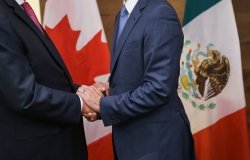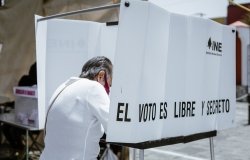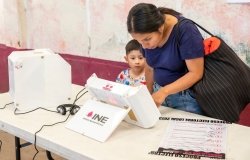Trusted Traveler Programs Are a No Brainer
In this analysis, Christopher Wilson discusses how trusted traveler and trusted shipper programs (SENTRI for individuals, FAST for shippers) facilitate vetted, safe individuals and shipments while strengthening border security.

As President Obama heads to Mexico to meet with his counterpart, Enrique Peña Nieto, bilateral economic ties are deeper and more massive than ever. In fact, in 2012 the volume of bilateral trade grew to the point that our countries trade a million dollars in goods and services every minute.1 With almost 80 percent of all bilateral merchandise trade crossing the land border, making sure the border is both secure and efficient is more important than ever.
Unfortunately, long lineups to cross the border currently cost the economies of the United States and Mexico billions of dollars each year in lost economic growth and eat away at the competitiveness of manufacturers working in the region. To eliminate the border bottleneck, investments in border infrastructure and staffing are important and necessary, but they are not cheap. One tried and true solution, however, is especially cost effective.
Trusted traveler and trusted shipper programs (SENTRI for individuals, FAST for shippers) facilitate vetted, safe individuals and shipments while strengthening border security. By voluntarily submitting to a vetting process, applicants provide Customs and Border Protection (CBP) with the intelligence needed to more accurately assess the risk presented by someone seeking entry to the United States. In return, crossers are offered expedited processing at the borders, which saves them time and money.
By speeding the passage of low-risk individuals and shipments, CBP officers are able to focus more time and energy on higher-risk or unknown traffic. That is, by making the proverbial haystack that officers must sift through smaller, CBP increases its chances of finding the needle. These programs are a win-win-win. They decrease wait times, minimize the need for additional staffing and lanes, and increase border security. While the programs have generally been successful, they also have a huge amount of untapped potential.
The SENTRI program, for example, expedites the passage of 18 percent of all northbound traffic. This is a significantly larger percentage than in previous years, but since the majority of traffic is made up of frequent crossers that live in border communities, the governments of the United States and Mexico should set a higher goal. Why not aim to have at least half of all individuals crossing the border go through SENTRI lanes by 2016? A similar goal could be set for the FAST program for commercial shippers. Achieving such goals would change the nature of border management and would cut border wait-times in a major way.
To reach such lofty targets, U.S. and Mexican officials from the federal and local levels and from the various competent agencies would have to work together. They would need to extend dedicated lanes as far back into Mexico as traffic backs up, so that program members do not have to wait in traffic before reaching their express lane. As a San Diego survey found, trusted traveler programs also suffer from a lack of adequate publicity.2 Creative approaches, such as application fee discount coupons being handed to frequent crossers, might also help. Finally, simply expanding the programs reach by increasing the number of ports of entry with SENTRI lanes would also move us closer to the goal.
The FAST program for commercial trucks appears to need particular attention. After seeing significant growth since its implementation in 2002, enrollment has actually declined since 2008. The full causes of this decline should be studied and addressed given the potential value to security and the competitiveness of regional manufacturing that the FAST program represents. Since FAST lanes can only be used when FAST drivers are carrying goods from a CTPAT supplier, special attention must be paid to developing an incentive structure to encourage participation in both programs.
The exact strategies to increase use of trusted traveler and trusted shipper programs along the U.S.-Mexico border may need some refining, but deciding to focus greater attention on the programs is a no brainer. They save money, speed up traffic and increase security. As Presidents Obama and Peña Nieto meet this week, they should consider directing their teams to set, and then reach, a much higher goal for SENTRI and FAST.
1. According to U.S. Census Bureau merchandise trade statistics and preliminary figures for 2012 services trade from the U.S. Bureau of Economic Analysis, total bilateral trade in 2012 was $536 billion. This means that, on average, there is $1.02 million in U.S.-Mexico trade each minute.
2. SanDiegoRed.com, “Despite the long waits, pedestrians ignore SENTRI,” August 25, 2011, http://www.sandiegored.com/noticias/17752/Despite-the-long-waits-pedestrians-ignore-SENTRI/.
Documents & Downloads
About the Author


Mexico Institute
The Mexico Institute seeks to improve understanding, communication, and cooperation between Mexico and the United States by promoting original research, encouraging public discussion, and proposing policy options for enhancing the bilateral relationship. A binational Advisory Board, chaired by Luis Téllez and Earl Anthony Wayne, oversees the work of the Mexico Institute. Read more








